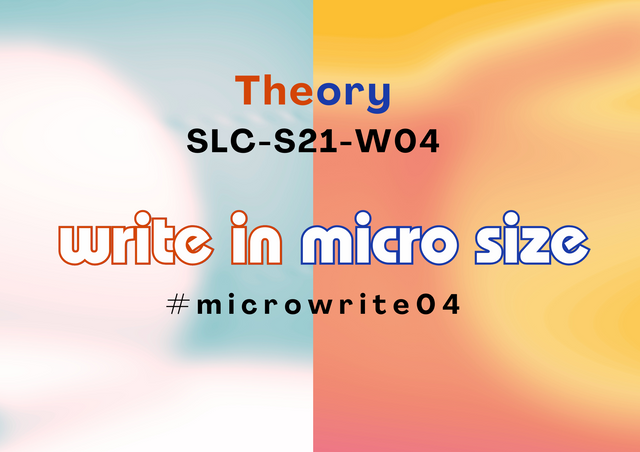 |
|---|

Welcome #Microwriters
What will we do this week 04?
- Objective: Adopt the structure of a micro-story to different literary genres.
- Task 1: I establish the Review of a character
- Tasks 2 to 3: I write 3 micro-stories in different literary genres.
- Make comments with a critical stance, offering suggestions for improvement.
But first, let's put things into context:
Today we will focus on one key concept:
Literary genres.
With week 4 we reach the halfway point of the short narrative workshop. We delve into exploring literary genres and how to use them in the construction of micro-stories.
What do we understand by Literary Genre?
Imagine that a “Literary Genre” is a big “hashtag” that we put on each micro-story that you have been creating during the workshop. This “category” that we assign allows us to classify them based on:
Classification of literary genres:
- Narrative: tells, describes reality or fiction.
- Lyric (poetic):transforms reality into images to generate emotions.
- The dramatic: Focus on dialogue, on the interaction of the characters.
- Didactics. To transmit knowledge, teachings, values.
We invite you to consult Wikipedia on the subject. Literary genres

Narrative Genre
Each genre has its own characteristics, structures and way of delivering content. Since this is a micro-story, we will focus on NARRATIVE and especially on “short narrative”. Narrative (long, short, or micro) has a structure and form, generally composed of:
- A content. This is the PLOT; the story that is told and how it is told.
- A structure or form in which we present it. How you arrange the elements of the plot: events, time, space in a Beginning; knot or conflict; outcome. (Example: last week's telegram)
- A way for the author to say what I want to express. Prose writing is the most commonly used form. Question: In last week's task 3, did you narrate a story or recite a poem?
But one of the fundamental characteristics of narrative is that THE AUTHOR turns to a “THE NARRATOR” to tell another: THE READER the story.
In this order, the micro-story is part of the narrative genre, as stated by Irene Andres Suárez and Pedro Peinado in the following references:
“…what we now call the micro-story, ... is a new discursive form that is situated at the limit of narrative expression and corresponds to the shortest link in the chain of narrativity , which from having three forms (novel, short novel and story) has gone on to have four: novel, short novel, story and micro-story.”
Micro-story and its varieties
The micro-story is a very short literary piece in prose that tells a story, that is, it is made up of narrativity . Once these conditions are met, there are micro-stories of all imaginable types: more or less lyrical, more or less experimental, realistic, surrealist, fantastic, humorous, erotic, terrifying... Always poignant, extremely precise, designed to inoculate a poisonous pleasure in the reader, addictive, in short.

Adapting the Micro-story to genres and varieties
It is important to consider:
- Brevity: Condensing the story to its essence.
- Conciseness: the right and necessary words.
- Clarity: It is preferable to have a single main idea without getting distracted.
- Role of the title: this is part of the story, it frames it, it advances the story.
- Impact: Seeks to create a lasting effect on the reader, in form or with surprises and twists
- Structure: How you organize the story according to genre

What are we going to do this week?
- Create micro-stories in three different genres. (Always focusing on the narrative)
- Make a review of a character at the request of the teachers.
- Identify in the comments the genre in which the other participants have written their stories.
Conclusion
The microfiction fits very well with different literary genres, forms and subgenres. For now, we are interested in keeping it as pure as possible. Later, by understanding the characteristics and basic structure of the microfiction, you will be able to create more varied and experimental stories.
Access the second part of this class Sinopsis

Notes:
Please complete the evaluation for Week 2. Link: Feedback from Week 2 We would appreciate your feedback on the first few weeks of the course.
Access the post with the tasks of the week 04:
Write in micro size 04 | SLC S21W04
- Images created on canva.com

 Original production by @joslud |
😱😱😱, saludos amiga, siento que está ruda la cosa jajajaja, dejame leer y leer, a ver la posibilidad de llevar a cabo este desafío. Bendiciones
Downvoting a post can decrease pending rewards and make it less visible. Common reasons:
Submit
Será una semana muy interesante pues habrá microrrelatos en varios géneros literarios. El reto es bueno!
Gran abrazo!
Downvoting a post can decrease pending rewards and make it less visible. Common reasons:
Submit
Hola amiga
Abrazos
Estás cordialmente invitada a practicar esta manera condensada de escribir, O como comentarista experta invitada.
Sería un honor.
Downvoting a post can decrease pending rewards and make it less visible. Common reasons:
Submit